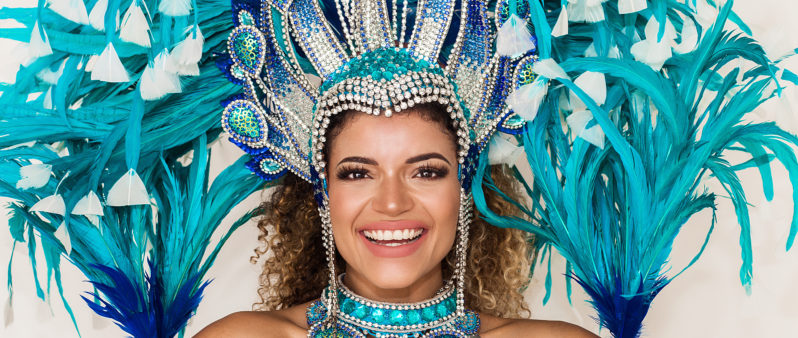
Carnival in Brazil: Everything You Need To Know About This Wild Cultural Event
Brazilian Carnival in a Nutshell: Your Guide To The Iconic Cultural Celebration
What do Mardi Gras, Venetian masks, and massive parades have in common? Carnival.
This big, colorful festival enchants people in countries all over the world and is celebrated in the most diverse ways.
And nowhere is Carnival more keenly and widely celebrated than in Brazil. From the north of the country to the south, Carnival is Brazil’s biggest party of the year. It’s a holiday from work—a time to enjoy music, dance, and party for days.
Here’s everything you need to know about Carnival in Brazil, including the best ways to enjoy it as a visitor to Brazil.
What is Carnival and Why do Brazilians Celebrate it?
Carnival is an annual Catholic festival that occurs leading up to Lent. Like Mardi Gras and other Carnivals worldwide, it’s a big celebration of the food and pleasures one must give up during Lent. In Brazil, the Carnival is a really big deal, and the people plan the festivities months in advance.
Because the celebrations happen during February and March, during Brazil’s summer, the ambiance is perfect for massive parties. There is even a common saying in Brazil that “the year starts only after Carnival,” referring to the number of people that take their holidays between New Year’s and Carnival, which itself is a national holiday.
You’ll see it when you visit: during this time, the beaches are usually packed, and so are the bars. Some stores just don’t open or only have reduced hours. The entire country seems to slow down, getting ready for the magic moment about to come.
When is Carnival?
Carnival celebrates the period leading up to Lent, ending on the Tuesday before Ash Wednesday. The official dates of Carnival vary from year to year, like Easter.
Generally, though, it takes place in February or early March.
What Will I See if I Go to Carnival?
Carnival typically involves many parades and street parties full of people with elaborate costumes and masks. You’ll see people indulging in food and drink, anticipating the fasting that will come with Lent.
But there are two main ways to experience Carnival in Brazil: in the stadium or streets.
Sambodromos (“Sambadromes”)
The escolas da samba (“samba schools”) in Rio de Janeiro and Sao Paulo are probably the most well-known aspects of Carnival, attracting tourists from around the globe.
In both cities, outstanding parades are held in Sambadromes, essentially entire arenas built especially for these massive parades. Various samba schools perform for four nights with well-decorated floats and thousands of dancers wearing elaborate costumes. These are accompanied by musicians playing lively drum sections. And they happen all night long.
To enjoy the party, you can either follow the parade or just enjoy the view from the stands (the best tickets sell quickly, so if you want a seat, make sure to buy it in advance).
Besides the beauty of these parades, they are also usually cultural representations. These escolas often use costumes, big floats, and original samba songs to explore history and even offer social critiques of various subjects such as politics, social inequality, or the environment.
Street Carnival
The beauty of the Brazilian Carnival goes way beyond the Sambadrome.
All across the country, street parties organized by specific groups called Blocos (“blocks,” as in “block parties”) offer a variety of options for celebrating—not only with samba but with several different music genres. You might hear traditional Brazilian Carnival marching songs mixed in with reggae, MPB, axé, and frevo (these last two genres are a fusion of typical Brazilian rhythms together with African influences).
You’ll often see a special truck equipped with speakers and a stage that carries a band that leads the party. These “trios elétricos“ travel throughout the streets, entertaining people with live concerts. They are especially popular in the northeast region, in states such as Bahia and Pernambuco.
Particularly in Pernambuco, the parades also traditionally feature giant dancing dolls representing famous characters or other figures from folk legends.
If you are more into partying in the street and dancing for days on end, the street Carnival scene might be your best choice.
Where to Go for the Best Brazilian Carnival Experience?
There are exciting Carnival events throughout Brazil from North to South. And while you’ll find that music, dancing, and magnificent costumes are staples of Carnival throughout the country, the celebration looks different depending on where you are.
Carnival in Rio de Janeiro
Rio has one of the best-known Carnivals in the country.
It’s massive, and the city turns into one huge party. It can get really wild and can also be overwhelming for some people.
If you’re looking for a non-stop party, Rio is a good choice. If you want something less intense, you may prefer another city.
São Paulo’s Carnival
Like Rio, São Paulo’s Carnival is huge. It may be less famous outside of Brazil, but it’s just as good. Be prepared for days full of extravagance and decadence.
While São Paulo’s Carnival is magnificent by any measure, it’s not a coastal city. If you want to take a break from dancing and have restful moments at the beach, this isn’t the city for you. Instead, head to Rio, Salvador, or Recife.
Recife and Olinda
Recife is the capital of Pernambuco, a state in the northeast region. Olinda, also in Pernambuco, is a small city known for its well-preserved colonial architecture.
Both cities have a world-class Carnival and are known for having less emphasis on the massive samba schools and more on the street carnival aspect. Both feature endless live music and are a little more friendly and warm than Rio and São Paulo.
Many Brazilians actually consider these the best Carnival celebrations in the country.
Salvador de Bahia
Salvado is the capital of Bahia, another northeastern state. This is the second-largest Carnival in the world, after Rio, and they throw the largest street party. Many actually call this Brazil’s “real” carnival because it is a more traditional celebration.
You won’t find the large parades, just miles and miles of street parties. They say that in Rio, you watch the parades; in Salvador, you are the parade.
In the Northern States and the Amazon
In the Northern states, like Amazonas, a traditional celebration called Carnaboi mixes elements from Carnival and indigenous folk traditions. Groups such as the bois-bumbá Caprichoso and Garantido create interactive plays and performances based on folklore and legends. They tell stories through dance and music, creating a mystical and vibrant ambiance.
In the Southern States
In the south, you can find some very different traditions, including festivals of rock music and even a Zombie Walk.
That’s right: in Curitiba, during Carnival Sunday, it has become a tradition for tens of thousands of people to dress as zombies and party around the city. This includes entire families and their pets.
Together, these zombies move through the streets in a type of living-dead parade that embraces everyone—especially those who are looking for an alternative to the traditional Carnival celebration.
The Best Carnival Tips for Newbies
Photo by: AlbertoBrazil on Pixabay
Interested in attending? Brazil would love to have you.
Use these tips to make it the experience of a lifetime.
- Choose what to do ahead of time. There are tons of events, but also tons of people. Choose the blocos and the escolas da samba you want to attend ahead of time so they don’t sell out. If you have to buy tickets, buy early from a legitimate vendor.
- Stay hydrated. Carnival takes place in Brazil’s summer… and it can get hot! Sure, enjoy a caipirinha or two, but also make sure to drink lots of water.
- Sunscreen is a must. Along the same lines, make sure you protect your skin from the sun. You wouldn’t want to miss out on the fun because you got lobster red on your first day! Even on cloudy days, make sure you’re protecting yourself.
- Choose clothes that are comfortable and can get dirty. You might feel like dressing up or trying out Brazilian street fashion to avoid looking like a tourist. But make sure you can wash everything you’re wearing and that you’re not wearing anything expensive… Carnival can ruin clothes. And make sure your outfit is comfortable—especially your shoes.
- Get creative with costumes. Carnival is a time to go a bit wild and have fun dressing up. Think Halloween, but fun rather than scary. Don’t be afraid to accessorize, wear bright colors, or use too much glitter.
- Stay safe. Brazil has a bit of a reputation for being unsafe, and I think some of that is exaggerated… but some isn’t. Stay safe by going in groups, not taking valuable items with you, and not keeping your phone and money in your pocket. You can keep your phone in a fanny pack or a pouch that hangs around your neck. Avoid walking through the streets at night—instead, take a taxi or Uber.
Carnival is the Great Brazilian Experience
As you can see, Carnival in Brazil is way more than samba!
In each region, you can find a diversity of rhythms, dance, friendly people, and a variety of cultural elements that you’ll enjoy to their fullest.
Brazilians love to party and celebrate, and Carnival is also about that. But in addition to the fun elements, Carnival is also about reflecting on Brazil’s history, culture, and even critiquing some aspects of its society.
It’s a very rich experience.
And while you can get by in English, learning Brazilian Portuguese will make it an even richer experience.
If you ever get the chance to explore the wonders of a Brazilian Carnival, don’t hesitate: grab your flashiest costume, get ready to dance, and don’t miss a thing.

No Comments for "Carnival in Brazil: Everything You Need To Know About This Wild Cultural Event"